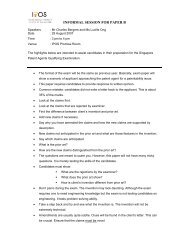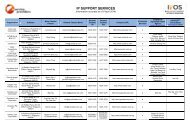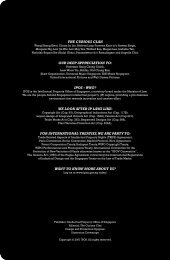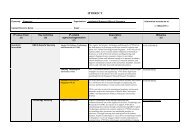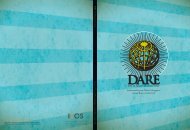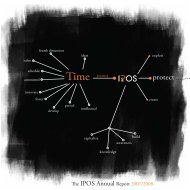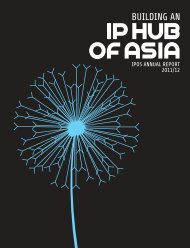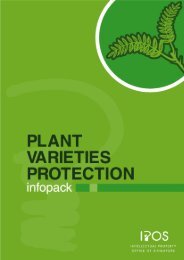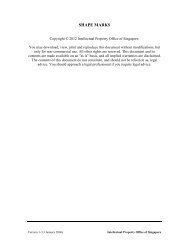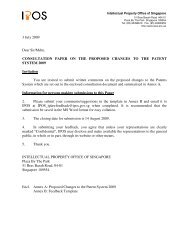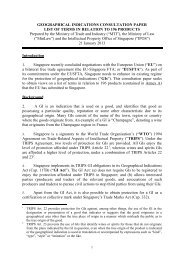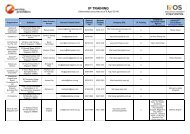Here - Intellectual Property Office of Singapore
Here - Intellectual Property Office of Singapore
Here - Intellectual Property Office of Singapore
You also want an ePaper? Increase the reach of your titles
YUMPU automatically turns print PDFs into web optimized ePapers that Google loves.
TRADE MARKS<br />
infopack<br />
Contents<br />
Introduction and Fundamentals 1<br />
Introduction<br />
Rights Conferred by a Registered Trade Mark<br />
Other Marks<br />
Legislation Governing Trade Marks<br />
Benefits <strong>of</strong> Trade Mark Registration<br />
When to File<br />
Priority Claim<br />
Registrable Marks<br />
Unregistrable Marks<br />
Classification <strong>of</strong> Goods and Services<br />
Identifying a Registered Trade Mark<br />
Not Registering a Trade Mark<br />
Ownership and Rights 5<br />
Entitlement to a Trade Mark<br />
Term and Renewals<br />
Proper and Continuous Use<br />
Infringement<br />
Well Known Marks<br />
Enforcement<br />
Falsely Representing Trade Marks as Registered<br />
Trade Marks and Internet Domain Names<br />
Application Process 8<br />
Filing an Application<br />
Process After Submission<br />
After Registration<br />
Applying for a Trade Mark outside 15<br />
<strong>Singapore</strong><br />
Introduction<br />
The Madrid Protocol<br />
Classification <strong>of</strong><br />
Goods and Services 17<br />
Frequently Used Terms in<br />
Trade Marks 19
Copyright © 2012 <strong>Intellectual</strong> <strong>Property</strong> <strong>Office</strong> <strong>of</strong> <strong>Singapore</strong>.<br />
You may download, view, print and reproduce this document, only for non-commercial use by yourself or your<br />
organisation, and only if you do not modify this document or its contents in any way. All other rights are reserved.<br />
This document and its contents are made available on an "as is" basis without warranties <strong>of</strong> any kind. To the fullest<br />
extent permitted by law, IPOS hereby disclaims all warranties relating to this document and its contents (including,<br />
without limitation, any warranty as to the accuracy, completeness, correctness, reliability, timeliness, quality or fitness<br />
for any particular purpose).<br />
The contents <strong>of</strong> this document are for general informational purposes only, and do not amount to legal advice. Please<br />
seek independent pr<strong>of</strong>essional advice before acting on any <strong>of</strong> the contents <strong>of</strong> this document.
1<br />
INTRODUCTION AND<br />
FUNDAMENTALS<br />
<strong>Intellectual</strong> <strong>Property</strong> (IP) refers to the product <strong>of</strong> your mind or intellect. IP can be an invention<br />
or innovation, special names and images used in trade, original designs or an expression <strong>of</strong> an idea. In<br />
<strong>Singapore</strong>, laws exist to protect such IP. This may be through a registration process such as patent<br />
grants for inventions, trade mark registration for signs used in trade, industrial design registration for<br />
designs applied to articles and grants <strong>of</strong> protection for plant varieties. Other forms <strong>of</strong> IP, that need not be<br />
registered, but may be protected nonetheless, include copyright, geographical indications, layoutdesigns<br />
<strong>of</strong> integrated circuits, confidential information and trade secrets.<br />
Introduction<br />
A Trade Mark is a sign used by a person in the course <strong>of</strong> business or trade to distinguish his goods or<br />
services from those <strong>of</strong> other traders.<br />
Registering a trade mark gives the owner rights to enable him to control the use <strong>of</strong> the sign.<br />
A registered trade mark has to be capable <strong>of</strong> being represented graphically. This sign can be any letter,<br />
word, name, signature, numeral, device, brand, heading, label, ticket, shape, colour, aspect <strong>of</strong> packaging<br />
or a combination <strong>of</strong> these.<br />
Rights Conferred by a Registered Trade Mark<br />
The rights conferred by a registered trade mark extend throughout <strong>Singapore</strong>. It confers on the owner the<br />
right to prevent others from using in <strong>Singapore</strong> as a trade mark, a mark similar to the mark registered,<br />
in relation to the same or similar goods or services in <strong>Singapore</strong>, without the owner's permission. The<br />
registered trade mark can last indefinitely, subject to renewal every 10 years. A registered trade mark is a<br />
form <strong>of</strong> property; it can be licensed or assigned.<br />
Other Marks<br />
Certification Mark<br />
A certification mark is a sign used to distinguish goods or services certified by the mark owner from other<br />
non-certified goods or services. In relation to the certified goods or services, the certification may relate<br />
to a characteristic, such as an indication <strong>of</strong> the origin, material, mode <strong>of</strong> manufacture <strong>of</strong> the goods, or<br />
performances <strong>of</strong> services, quality, accuracy or other characteristics.<br />
Unlike trade marks, certification marks are not applied by those who trade in the goods or services but<br />
by the one who certifies the particular characteristics <strong>of</strong> the goods or services.<br />
Collective Mark<br />
A collective mark is a sign used to distinguish the goods or services <strong>of</strong>fered by members <strong>of</strong> an<br />
association or group <strong>of</strong> traders from goods or services <strong>of</strong> those who are non-members <strong>of</strong> the association.<br />
An association can file for the registration <strong>of</strong> a collective mark. Once registered, members <strong>of</strong> the<br />
association are allowed to use the collective mark. A collective mark represents membership <strong>of</strong> the<br />
provider <strong>of</strong> goods or services to a particular association.<br />
Marks used by Government Agencies (Rule 13)<br />
IPOS maintains a separate database for logos and other devices <strong>of</strong> government bodies, statutory boards<br />
or institutions that may not qualify as trade marks either because they are not used or proposed to be<br />
used in the course <strong>of</strong> trade or no goods or services are provided. When a logo in this database is<br />
identical or similar to a trade mark sought to be registered, IPOS will request that the applicant seek the<br />
consent <strong>of</strong> the relevant government body or institution that has an interest in the logo.<br />
1
1 - INTRODUCTION AND FUNDAMENTALS<br />
Legislation Governing Trade Marks<br />
The Trade Marks Act (2005 Revised Ed) (Cap. 332), together with its subsidiary legislation which<br />
consists <strong>of</strong> the Trade Marks Rules and Trade Marks (International Registration) Rules, form the<br />
legislation governing the registration <strong>of</strong> trade marks in <strong>Singapore</strong>.<br />
>> View the Trade Marks Act (Cap. 332) online at the AGC website http://statutes.agc.gov.sg.<br />
>> Copies <strong>of</strong> the legislation are available at http://www2.toppanleefung.com/webshop or<br />
Toppan Leefung Pte. Ltd. at 1 Kim Seng Promenade, Great World City East Tower, #18-01 <strong>Singapore</strong> 237994,<br />
Tel (65) 6826 9685 / 6826 9629.<br />
Benefits <strong>of</strong> Trade Mark Registration<br />
Although it is not compulsory to register a trade mark in order to use it, a trade mark registration adds<br />
great value to a business. By filing for trade mark registration, the trade mark owner obtains a right to<br />
ownership and the right to prevent others from using a similar mark without his permission.<br />
>> Please refer to "Not Registering a Trade Mark" on page 4 for more information on the common law<br />
action <strong>of</strong> “passing <strong>of</strong>f” for trade mark protection.<br />
The owner <strong>of</strong> the registered trade mark can exploit his mark in many ways. He may use it to better<br />
protect his market share (i.e. his pr<strong>of</strong>its) by barring others from copying it; he may license it to third<br />
parties for commercial returns (e.g. through a franchise); he may sell the mark outright for a specified<br />
value (e.g. in a company acquisition); or he may use the mark to raise equity for his business<br />
undertakings.<br />
When to File<br />
Unlike patents or registered designs, trade marks that are already in use may still be registered. There is<br />
no time limit as to when the owner may apply for a registration.<br />
Although there is no time limit for filing, it should be noted that a suit for an infringement <strong>of</strong> a registered<br />
trade mark is only possible if the trade mark is registered. A trade mark registration takes effect from the<br />
date <strong>of</strong> filing.<br />
Priority Claim<br />
<strong>Singapore</strong>, like many countries, allows priority claims in trade mark applications. If an applicant has a<br />
corresponding application filed earlier in a Paris Convention country or a World Trade Organization<br />
member country (other than <strong>Singapore</strong>), he may claim priority from this first-filed application, provided the<br />
<strong>Singapore</strong> registration is filed within six months from the date <strong>of</strong> the first filing. When a priority is claimed,<br />
the filing date in <strong>Singapore</strong> dates back to the date <strong>of</strong> the first filing. Similarly, an application which is first<br />
filed in <strong>Singapore</strong> can be used to claim priority in a corresponding application filed in a Paris Convention<br />
country or a World Trade Organization member country, provided that the corresponding application is filed<br />
within six months from the date <strong>of</strong> the first-filed <strong>Singapore</strong> application.<br />
>> The corresponding application is a separate application filed outside <strong>Singapore</strong> for the same trade<br />
mark.<br />
Registrable Marks<br />
A trade mark can be letters, words, names, signatures, numerals, devices, brands, labels, tickets,<br />
shapes, colours, aspects <strong>of</strong> packaging or any combination <strong>of</strong> these. For a trade mark to be registered, it<br />
must be distinctive and capable <strong>of</strong> distinguishing the goods and/or services <strong>of</strong> the owner from similar<br />
goods and/or services <strong>of</strong> other traders.<br />
2
<strong>Here</strong> are some examples:<br />
Based on invented words -<br />
Based on device, a combination <strong>of</strong><br />
alphabet(s), or word(s) with picture -<br />
1 - INTRODUCTION AND FUNDAMENTALS<br />
Unregistrable Marks<br />
The following are some common examples <strong>of</strong> the marks that cannot be registered under the trade mark<br />
law in <strong>Singapore</strong>:<br />
Descriptive Marks:<br />
Marks 'Common to<br />
the Trade':<br />
Marks Contrary to:<br />
Public Policy or<br />
Morality<br />
Deceptive Marks:<br />
Marks that are Identical to:<br />
Earlier Marks<br />
Marks that Could:<br />
Cause Confusion<br />
Marks that are Identical:<br />
/Similar to Well Known Mark<br />
Marks that describe the goods and services <strong>of</strong> the business. For<br />
instance, marks that describe the quality ('Super' or 'Best'), quantity<br />
('One dozen'), value ('Cheap'), intended purpose ('Cleaner'), or<br />
geographical origin.<br />
Marks that are signs or indications that are or have become<br />
customary in the trade. Some marks have become so well accepted<br />
that the term is used to describe the type <strong>of</strong> the goods or services in<br />
general, and no longer serves to distinguish the products <strong>of</strong>fered. An<br />
example <strong>of</strong> a trade mark that has become customary in the industry<br />
is "escalator".<br />
Marks that are generally contrary to public policy or morality. For<br />
example, a mark that could promote immoral behaviour cannot be<br />
registered.<br />
Marks that attempt to deceive the public. For example, marks that<br />
misrepresent the nature, quality or geographical origin <strong>of</strong> the goods<br />
or services.<br />
A trade mark will not be registered if it is identical with an earlier mark<br />
and the goods or services for which the trade mark is sought to be<br />
registered are identical with the goods or services for which the<br />
earlier mark is protected.<br />
A trade mark may not be registered if it is likely to cause the public to<br />
be confused under these circumstances:<br />
• it is identical with an earlier mark and is to be registered for<br />
goods or services similar to those for which the earlier mark is<br />
protected;<br />
• it is similar to an earlier trade mark and is to be registered for<br />
goods or services identical with those for which the earlier<br />
mark is protected; or<br />
• it is similar to an earlier trade mark and is to be registered for<br />
goods or services similar to those for which the earlier trade<br />
mark is protected.<br />
A trade mark may not be registered if it is identical or similar to an<br />
earlier mark that is well known in <strong>Singapore</strong>. Please refer to page 6<br />
on Well Known Marks.<br />
>> IPOS provides public access to its records <strong>of</strong> trade mark applications and trade marks registered in<br />
<strong>Singapore</strong>. Any member <strong>of</strong> the public may access these records at the Public Search Area at IPOS<br />
or via eTrademarks at the IPOS website www.ipos.gov.sg<br />
In general, trade marks that do not have a distinctive character cannot be registered. However, there<br />
may be exceptions where the company has built up its branding to such an extent that the mark is<br />
associated with the company, even though the mark in itself was not distinctive. For such cases, the<br />
mark may still be registered on the basis <strong>of</strong> substantial use resulting in the mark acquiring a distinctive<br />
character. “Sharp” (for televisions) and “Digital” (for computers) are examples <strong>of</strong> such marks.<br />
3
1 - INTRODUCTION AND FUNDAMENTALS<br />
Classification <strong>of</strong> Goods and Services<br />
The scope <strong>of</strong> a trade mark registration is determined by the goods or services in relation to which the trade<br />
mark is registered. For the purpose <strong>of</strong> trade mark registration, <strong>Singapore</strong> uses the International<br />
Classification <strong>of</strong> Goods and Services as prescribed by the Nice Agreement to classify trade mark<br />
registrations. The Nice Agreement is an international agreement on classification <strong>of</strong> goods and services to<br />
which <strong>Singapore</strong> is a party. This classification sets out the list <strong>of</strong> goods and services for which the<br />
applicant may wish to register for in relation to his trade mark. The list groups these goods and services into<br />
classes in which these goods and services belong. There are a total <strong>of</strong> 34 classes <strong>of</strong> goods and 11<br />
classes <strong>of</strong> services (page 17).<br />
>> The Nice Classification is a tool for the classification <strong>of</strong> goods and services for the purposes <strong>of</strong> the registration <strong>of</strong><br />
marks. It is used in more than 140 countries worldwide and in international applications for the registration <strong>of</strong><br />
marks under the Madrid Agreement and Protocol.<br />
Trade Mark Information Search<br />
Before registering a trade mark, it is advisable to first conduct a search <strong>of</strong> the existing trade marks to<br />
ensure its registrability. There are resources available to help search for existing trade marks.<br />
accessible via the IPOS website www.ipos.gov.sg, is a one-stop website to facilitate online trade mark<br />
searches and online filing <strong>of</strong> trade mark applications and related transactions in <strong>Singapore</strong>.<br />
The eTradeMarks<br />
Search Terminals<br />
available at IPOS’ Public Search Area allow the public to access<br />
IPOS’ records <strong>of</strong> trade mark applications and trade marks<br />
registered in <strong>Singapore</strong>. The relevant usage and printing fees will<br />
apply.<br />
Note: These tools and resources provide non-exhaustive searches. Applicants are advised to check the<br />
databases <strong>of</strong> other countries for trade marks registered in the respective countries.<br />
Identifying a Registered Trade Mark<br />
® and are common symbols associated with trade marks. ® indicates that the mark is a registered<br />
trade mark and hence protected under the trade mark law. is just a symbol used to indicate that the<br />
mark is used by the company as a trade mark. It does not denote that the mark is registered nor<br />
protected under the trade mark law.<br />
Not Registering a Trade Mark<br />
It is not compulsory to register a trade mark in <strong>Singapore</strong>. An individual, firm or company, who owns a<br />
trade mark and uses it in connection with his goods or services, acquires common law rights in that mark<br />
by virtue <strong>of</strong> the use and reputation <strong>of</strong> the mark.<br />
>> Common law generally refers to the law based on past decisions and general principles, serving as<br />
precedent or is applied to situations not covered by statutes.<br />
For a mark that is not registered, the owner can only rely on the common law action <strong>of</strong> “passing <strong>of</strong>f” to<br />
protect his mark against imitation or infringement. This remedy, however, requires the owner <strong>of</strong> the mark<br />
to prove his reputation and goodwill. The requirement <strong>of</strong> proving reputation and goodwill may pose some<br />
problems where the business, or the use <strong>of</strong> the trade mark, has not been established for a substantial<br />
period <strong>of</strong> time.<br />
A registered trade mark, on the other hand, grants the owner <strong>of</strong> the trade mark a statutory monopoly. If<br />
someone else uses the same or a similar mark on the same or similar goods or services in respect <strong>of</strong><br />
which the mark is registered, the registered trade mark owner can rely on his registration as pro<strong>of</strong> <strong>of</strong> his<br />
right to the mark and sue for infringement.<br />
4
2 OWNERSHIP AND RIGHTS<br />
Entitlement to a Trade Mark<br />
An individual, firm or company claiming to be the owner <strong>of</strong> a trade mark can file for a trade mark<br />
registration as long as they are using or intend to use the mark in the course <strong>of</strong> their business. There are<br />
no restrictions or discrimination as to nationality or residency. However, an applicant who is not a<br />
resident in <strong>Singapore</strong> must provide the Registry <strong>of</strong> Trade Marks with an address for service in <strong>Singapore</strong><br />
to which all correspondences will be sent.<br />
Term and Renewals<br />
The registration <strong>of</strong> a trade mark is valid for 10 years from the date <strong>of</strong> application. Protection can last<br />
indefinitely subject to the payment <strong>of</strong> renewal fees every 10 years, and with proper use <strong>of</strong> the mark.<br />
Proper and Continuous Use<br />
The owner <strong>of</strong> the registered trade mark should use his mark properly and continuously. He should<br />
display the trade mark in every medium in which he uses to protect his brand or corporate logo. For<br />
example, displaying the mark prominently in packaging, labels, websites, advertisements, press<br />
releases, trade shows, business documents and the like.<br />
Furthermore, the trade mark owner should be vigilant to ensure that the trade mark is used in its proper<br />
context. For example, he should not use a trade mark to describe the product itself, e.g. use "a XYZ<br />
copier" instead <strong>of</strong> "a XYZ" and "make two copies on a XYZ copier" instead <strong>of</strong> "XYZ two copies".<br />
Such good practices may prevent a successful claim by an infringing party (defendant) that the mark has<br />
become a "generic" word and thus rendered unenforceable under the law. There are numerous<br />
examples <strong>of</strong> valuable trade mark names that have become common in the trade in this way (e.g.<br />
escalator). 'Genericide' occurs when a trade mark, previously used by an individual manufacturer for his<br />
products, becomes a description <strong>of</strong> the product itself.<br />
Whenever and wherever possible, a registered trade mark should be actively applied to reinforce the<br />
trade mark identity with its associated type(s) <strong>of</strong> goods or services. Sufficient effort must be put in to<br />
prevent misuse or infringement <strong>of</strong> the registered trade mark.<br />
If an infringing party uses a registered mark continuously for five years without being stopped by the<br />
trade mark owner, it may be deemed that the owner has consented to such a use. Therefore, if an<br />
infringement proceeding against the infringing party takes place after five years, the infringing party may<br />
defend himself on the basis <strong>of</strong> lack <strong>of</strong> action or protest by the trade mark owner.<br />
If a registered trade mark has not been used consecutively for five years, there is a risk <strong>of</strong> the trade mark<br />
being removed from the Register. Any interested party can apply to the Registry <strong>of</strong> Trade Marks to have<br />
an inactive registered trade mark removed by showing pro<strong>of</strong> <strong>of</strong> non-use (see “Revocation” on page 14).<br />
5
2 - OWNERSHIP AND RIGHTS<br />
Infringement <strong>of</strong> Registered Trade Mark Rights<br />
Infringement occurs when a registered trade mark is used in the course <strong>of</strong> trade without the consent <strong>of</strong><br />
the trade mark owner.<br />
An infringement may come about through the use <strong>of</strong><br />
• an identical mark on identical goods or services; or<br />
• an identical mark on similar goods or services, or a similar mark on identical/similar goods or<br />
services resulting in confusion on the part <strong>of</strong> the public.<br />
The use <strong>of</strong> a sign similar to a registered trade mark which is well known in <strong>Singapore</strong> on goods or<br />
services that are dissimilar to the registered well known mark may also constitute an infringement if there<br />
exists a likelihood <strong>of</strong> confusion, an indication <strong>of</strong> connection, and possible damage to the interests <strong>of</strong> the<br />
owner.<br />
Well Known Marks<br />
Well known marks are <strong>of</strong>fered greater scope <strong>of</strong> protection. Even if they are not registered in <strong>Singapore</strong>,<br />
the owner <strong>of</strong> the well known trade mark may take action against the use <strong>of</strong> a trade mark/ business<br />
identifier under the following circumstances:<br />
1. The use <strong>of</strong> the trade mark/business identifier would indicate a connection between those goods or<br />
services and the owner <strong>of</strong> the well known trade mark, and is likely to damage the interests <strong>of</strong> the<br />
owner <strong>of</strong> the well known trade mark.<br />
2. If the trade mark is well known to the public at large in <strong>Singapore</strong>, where the use <strong>of</strong> the trade<br />
mark/business identifier would:<br />
• cause dilution in an unfair manner <strong>of</strong> the distinctive character <strong>of</strong> the well known trade mark; or<br />
• take unfair advantage <strong>of</strong> the distinctive character <strong>of</strong> the well known trade mark.<br />
>> Dilution means the lessening <strong>of</strong> the capacity <strong>of</strong> the trade mark to identify and distinguish goods or<br />
services, regardless <strong>of</strong> whether (a) there is any competition between the owner <strong>of</strong> the trade mark<br />
and any other party; or (b) there is any likelihood <strong>of</strong> confusion on the part <strong>of</strong> the public.<br />
>> Business identifier means any sign capable <strong>of</strong> being represented graphically which is used to<br />
identify any business.<br />
>> A number <strong>of</strong> factors that may be considered in determining whether a mark is well known in<br />
<strong>Singapore</strong> such as:<br />
• the degree <strong>of</strong> knowledge/recognition by the relevant sector <strong>of</strong> the public in <strong>Singapore</strong>;<br />
• the duration, extent and geographical area <strong>of</strong> the use or promotion <strong>of</strong> the mark;<br />
• any registration/application for registration in any country;<br />
• any successful enforcement <strong>of</strong> the mark in any country;<br />
• any value associated with the mark.<br />
Generally, if a mark is well known to a relevant sector <strong>of</strong> the public in <strong>Singapore</strong>, it can be considered<br />
well known in <strong>Singapore</strong>. This "relevant sector" may include actual/potential customers <strong>of</strong> the<br />
goods/services, those involved in the distribution <strong>of</strong> goods/services or businesses dealing in the<br />
goods/services.<br />
6
2 - OWNERSHIP AND RIGHTS<br />
Enforcement <strong>of</strong> Registered Trade Mark Rights<br />
Once an infringement <strong>of</strong> a registered trade mark is established, the owner can enforce his rights as<br />
conferred by the Trade Marks Act. He can take legal action against the infringing party by seeking relief<br />
in the form <strong>of</strong> an injunction and either demanding for the pr<strong>of</strong>its gained by the infringing party at his<br />
expense or seeking damages for the loss suffered.<br />
When awarding damages, the Court may also award on account <strong>of</strong> pr<strong>of</strong>its attributable to the infringement<br />
that have not been taken into account in computing the damages.<br />
In an infringement action involving the use <strong>of</strong> a counterfeit trade mark in relation to goods or services, the<br />
owner <strong>of</strong> the registered trade mark has an additional alternative remedy <strong>of</strong> statutory damages.<br />
>> A counterfeit trade mark is any sign that is identical with or so similar to the registered trade mark<br />
as to be calculated to deceive and is applied to goods or services without the consent <strong>of</strong> the owner<br />
to falsely represent the goods or services to be the genuine goods or services <strong>of</strong> the owner <strong>of</strong> the<br />
registered trade mark.<br />
Making False Representation – A Criminal Offence<br />
It is a criminal <strong>of</strong>fence to falsely represent a trade mark as registered when it is not registered or if it is<br />
pending registration, or make a false representation as to the goods or services for which a trade mark is<br />
registered.<br />
Trade Marks and Internet Domain Names<br />
The Internet has become an important marketing channel and trading platform for products and services<br />
in recent years.<br />
As marketers continue to exploit their registered trade marks on the Internet, domain names have<br />
inevitably become part <strong>of</strong> their invaluable brand assets.<br />
In practice, domain names are registered on a first-come-first-served basis. If a trade mark has the<br />
potential <strong>of</strong> becoming valuable, the unscrupulous may decide to register the domain name using the<br />
trade mark name and later <strong>of</strong>fer it to the trade mark owner in exchange for a huge sum <strong>of</strong> money. To<br />
avoid being victims <strong>of</strong> these so-called 'cybersquatters', a registered trade mark owner should register his<br />
domain name before anyone else does.<br />
>> A domain name is an electronic address that identifies a location on the Internet, somewhat like<br />
street names in cities, e.g. the domain name <strong>of</strong> <strong>Intellectual</strong> <strong>Property</strong> <strong>Office</strong> <strong>of</strong> <strong>Singapore</strong> (acronym<br />
IPOS) is www.ipos.gov.sg.<br />
In <strong>Singapore</strong>, local domain names (those with the extension ".sg") are assigned by the Registrars<br />
accredited by the <strong>Singapore</strong> Network Information Centre (SGNIC) www.nic.net.sg. On request and<br />
upon payment <strong>of</strong> a fee, the Registrar will assign your company a domain name. As the registration<br />
is administered on a first-come-first-served basis, it may be possible that someone else would have<br />
registered the domain name before you.<br />
7
3 APPLICATION PROCESS<br />
Filing the Application<br />
The applicant may file the application form and pay the prescribed fee electronically via eTradeMarks,<br />
accessible from the IPOS website www.ipos.gov.sg, or directly to the <strong>Intellectual</strong> <strong>Property</strong> <strong>Office</strong> <strong>of</strong><br />
<strong>Singapore</strong>.<br />
The applicant needs to furnish the following information to obtain a filing date: (1) a statement that a<br />
request for registration is sought, (2) name and address <strong>of</strong> the applicant, (3) a clear graphical<br />
representation <strong>of</strong> the mark, (4) a list <strong>of</strong> goods and services sought for registration, classified according<br />
to the International Classification <strong>of</strong> Goods and Services, (5) a declaration <strong>of</strong> use/intent to use the<br />
trade mark, and (6) the prescribed fee. From 2nd July 2007, the applicant may file for registration in<br />
one application in respect <strong>of</strong> several classes <strong>of</strong> goods or services. When several classes <strong>of</strong> goods or<br />
services are filed in one application, the application leads to only one registration.<br />
The application will be processed when the above particulars are furnished in the prescribed form.<br />
• For marks comprising <strong>of</strong> a three-dimensional shape <strong>of</strong> the goods or packaging, the representation<br />
may be represented by line drawings. If a single-view line drawing is insufficient, multiple aspect<br />
views but up to a maximum <strong>of</strong> six views should be provided.<br />
• For marks with non-English words and/or non-Roman characters, the English translation and/or<br />
transliteration (i.e. pronunciation) must be given in the application.<br />
>> Before filing an application for the registration <strong>of</strong> a trade mark in <strong>Singapore</strong>, it is advisable to first<br />
conduct a search <strong>of</strong> the existing trade marks in the records maintained by the Registry <strong>of</strong> Trade<br />
Marks. This is to ensure that there is no prior trade mark that is identical or similar to the one you<br />
intend to use, particularly in the area <strong>of</strong> your business. The search can be conducted at the IPOS<br />
Public Search Area or via eTradeMarks at the IPOS website www.ipos.gov.sg.<br />
>> In <strong>Singapore</strong>, the application process for the registration <strong>of</strong> collective marks and certification marks<br />
is similar to the trade mark process. However, the applications must be accompanied by a set <strong>of</strong><br />
Regulations governing the use <strong>of</strong> the collective and certification marks within nine months from the<br />
date <strong>of</strong> filing the application. Please refer to the requirements in the First and Second Schedules <strong>of</strong><br />
the Trade Marks Act (Cap. 332, 2005 Ed.) for the requirements for the registration <strong>of</strong> collective<br />
marks and certification marks. The marks are published in the Trade Marks Journal in a separate<br />
section titled "Collective and Certification Marks Applications Published for Opposition Purposes"<br />
for opposition purposes before protection is granted.<br />
Priority Claim<br />
If the applicant wishes to claim priority, the claim has to be made at the point <strong>of</strong> filing the application. It is<br />
possible to claim priority from more than one priority application, or for some but not all the goods or<br />
services in the priority application. Priority documents and translations (if applicable) will only need to be<br />
furnished if it is requested for by the Registry <strong>of</strong> Trade Marks.<br />
Address for Service<br />
An address for service in <strong>Singapore</strong> must be provided in all trade mark applications. This is the address<br />
to which all correspondences from the Registry <strong>of</strong> Trade Marks will be sent. Where there is a change in<br />
the address for service, the applicant has to notify the Registry <strong>of</strong> Trade Marks by filing the relevant form<br />
with the prescribed fee.<br />
8
3 - APPLICATION PROCESS<br />
Estimated Processing Time<br />
The application should be examined in about two months from the filing date, and we will inform the<br />
Applicant in writing if the application is in order for acceptance and publication, or if there are objections<br />
affecting the application.<br />
Forms and Fees<br />
A list <strong>of</strong> the forms and fees pertaining to trade marks is enclosed at the back <strong>of</strong> this infopack. All forms<br />
are available at the Registry <strong>of</strong> Trade Marks and are downloadable from the IPOS website<br />
www.ipos.gov.sg (Forms and Fees>Trade Marks).<br />
eTradeMarks<br />
eTrade Marks, accessible at the IPOS website www.ipos.gov.sg, is a one-stop solution to facilitate online<br />
trade mark searches and online filing <strong>of</strong> trade mark applications and related transactions in <strong>Singapore</strong>.<br />
eTradeMarks services include<br />
1. Search <strong>of</strong> the trade marks database for:<br />
• similar trade marks; and<br />
• other information on trade marks such as image <strong>of</strong> the trade mark, owner details and goods and<br />
services claimed.<br />
2. Online filing <strong>of</strong>:<br />
• application for the registration <strong>of</strong> a trade mark;<br />
• application for the registration <strong>of</strong> a collective mark or certification mark;<br />
• request to appoint or change an agent or to enter or change an address for service;<br />
• change <strong>of</strong> name or other particulars <strong>of</strong> applicant/proprietor;<br />
• application to register a change <strong>of</strong> ownership;<br />
• request to change details <strong>of</strong> an application;<br />
• request for an extension <strong>of</strong> time to respond to the Registrar’s written notice in relation to:<br />
- the application for registration,<br />
- the application for renewal or restoration <strong>of</strong> a removed trade mark, and<br />
- the application to register an assignment, or licence or grant <strong>of</strong> any security interest; and<br />
• renewal <strong>of</strong> trade mark registration.<br />
For an updated list <strong>of</strong> services <strong>of</strong>fered by eTradeMarks, please visit the IPOS website www.ipos.gov.sg.<br />
9
3 - APPLICATION PROCESS<br />
Application Submission<br />
The application may be sent to the Registry <strong>of</strong> Trade Marks by hand, mailed to the address below or<br />
electronically filed using eTradeMarks, available at the IPOS website www.ipos.gov.sg.<br />
Address:<br />
Registrar <strong>of</strong> Trade Marks<br />
Registry <strong>of</strong> Trade Marks<br />
<strong>Intellectual</strong> <strong>Property</strong> <strong>Office</strong> <strong>of</strong> <strong>Singapore</strong><br />
51 Bras Basah Road<br />
#04-01 Manulife Centre<br />
<strong>Singapore</strong> 189554<br />
Business Hours:<br />
Monday to Friday: 8:30am to 5:30pm<br />
Saturday, Sunday and Public Holiday: CLOSED<br />
Payment Hours:<br />
Monday to Friday: 8:30am to 5:00pm<br />
Payment can be made by NETS, cashcard, GIRO, cheques (crossed), money order and bank draft (in<br />
<strong>Singapore</strong> dollars) made out to <strong>Intellectual</strong> <strong>Property</strong> <strong>Office</strong> <strong>of</strong> <strong>Singapore</strong>.<br />
For submission by mail, the application form must be completed and duly signed, and be accompanied<br />
with all the required documents as well as payment in the form <strong>of</strong> a cheque/money order/bank draft/the<br />
request for GIRO payment.<br />
Customer Enquiry Hotline : (65) 6339 8616<br />
Fax : (65) 6339 0252<br />
Email : ipos_enquiry@ipos.gov.sg<br />
Process After Submission<br />
Formalities Examination<br />
The Registry <strong>of</strong> Trade Marks would conduct a formalities examination upon receipt <strong>of</strong> the application and<br />
fees. This entails a check that the application contains the minimum required information and the fee<br />
paid, whereupon a trade mark number and a filing date will be allocated. The application is also checked<br />
if it is made in the prescribed form and that the classification <strong>of</strong> goods and services has been indicated.<br />
Search<br />
After the application has passed the formalities examination, the Trade Mark Examiners in the Registry<br />
<strong>of</strong> Trade Marks will conduct a search to see if the mark applied for looks or sounds the same as any<br />
other trade mark which is already registered or has already been applied for by someone else for the<br />
same or similar goods or services. The examiners will also search to see if the mark consists <strong>of</strong> or<br />
contains a geographical name. In the case <strong>of</strong> pharmaceutical products, the Registry <strong>of</strong> Trade Marks will<br />
also need to check whether the mark consists <strong>of</strong> a protected International Non-Proprietary Name (INN).<br />
The INNs, furnished by the World Health Organization, are generic names for specific pharmaceutical<br />
substances. All <strong>of</strong> the above may give rise to grounds for objections raised against the trade mark<br />
application.<br />
In addition, the specification <strong>of</strong> goods or services will be checked to ensure that it conforms to the<br />
International Classification <strong>of</strong> Goods and Services. A wrong classification will result in the application<br />
being rejected by the Registrar and a fresh application may have to be filed. From the applicant’s<br />
perspective, a wrong classification may result in the applicant’s mark not being asserted in priority vis-àvis<br />
later applications.<br />
10
3 - APPLICATION PROCES<br />
Examination<br />
After the searches have been conducted, the application will be examined to determine whether the mark<br />
is registrable in accordance with the law. The examiner will check to ensure that the mark does not fall<br />
into the areas not allowed by law, for example, marks that are devoid <strong>of</strong> any distinctive character.<br />
If the examiners have any objections to the mark, they will inform the applicant <strong>of</strong> their objections, and<br />
grant the applicant a specified period <strong>of</strong> time in which to overcome the objection. The applicant may also<br />
request for an extension <strong>of</strong> time in which to answer such objections.<br />
Publication<br />
Once the objections have been overcome, or if there are no objections, the applicant will be informed <strong>of</strong><br />
the acceptance <strong>of</strong> the application for registration and the acceptance will be published for public<br />
information in the Trade Marks Journal. Any interested party may oppose the registration <strong>of</strong> the mark<br />
within two months <strong>of</strong> the publication.<br />
>> The latest Trade Marks Journal may be downloaded from eTrademarks available at the IPOS<br />
website www.ipos.gov.sg.<br />
Opposition<br />
Opposition is the process whereby members <strong>of</strong> the public, or any interested third party may object to the<br />
grant <strong>of</strong> a trade mark registration if they have valid grounds for doing so. The grounds <strong>of</strong> opposition may<br />
include reasons such as the application is similar to a registered or pending mark, and so forth.<br />
Once a notice <strong>of</strong> opposition is received, the applicant must respond with a counter-statement to respond<br />
to the opposition. Both the applicant and opponent must supply evidence to support their respective<br />
cases. The parties will then appear before a Registrar <strong>of</strong> the Hearings and Mediation Division,<br />
whereupon a decision on the application will be made after hearing both parties.<br />
After the hearing, the Registrar will give the grounds <strong>of</strong> decision based on the information and evidence<br />
presented by both parties.<br />
>> Summaries <strong>of</strong> the recent hearing decisions are available at the IPOS website www.ipos.gov.sg<br />
(About IP > IP Resources > Legal Decisions).<br />
Registration<br />
If the opposition to the registration is resolved in favour <strong>of</strong> the applicant, or if there are no opposition, the<br />
trade mark will be registered and a registration certificate will be issued.<br />
11
3 - APPLICATION PROCES<br />
Flowchart <strong>of</strong> a Trade Mark Application<br />
Submission <strong>of</strong><br />
Trade Mark Application<br />
Formalities Examination<br />
Search<br />
Application will be checked for completeness and whether the<br />
representation <strong>of</strong> the mark provided is acceptable. A trade mark<br />
number and date <strong>of</strong> application will be allocated.<br />
Search for conflicting marks, geographical names, and<br />
conformance to the International Classification <strong>of</strong> Goods<br />
and Services*<br />
Examination<br />
Examine if the mark is registrable in accordance to the<br />
Trade Marks Act.<br />
Publication<br />
Upon acceptance, the application will be published in the<br />
Trade Marks Journal which may be accessed by any<br />
member <strong>of</strong> the public.<br />
notice <strong>of</strong> opposition<br />
Opposition Proceedings<br />
Any interested party<br />
may oppose the<br />
registration <strong>of</strong> the<br />
mark within 2 months<br />
<strong>of</strong> publication.<br />
Outcome <strong>of</strong> hearing not in<br />
favour <strong>of</strong> the applicant.<br />
Outcome <strong>of</strong> hearing in favour <strong>of</strong><br />
the applicant.<br />
Successful Registration<br />
Application Refused<br />
12
3 - APPLICATION PROCESS<br />
REGISTRY APPLICANT OPPONENT**<br />
Informs applicant in writing<br />
if there are amendments<br />
required or deficiencies<br />
spotted.<br />
Rejects the application if<br />
the mark conflicts with the<br />
search criteria.<br />
Informs applicant <strong>of</strong><br />
objections, if any, and<br />
allows the applicant to<br />
revert.<br />
To make the<br />
amendments or correct<br />
the deficiencies spotted.<br />
Otherwise, the<br />
application is deemed<br />
never to have been made<br />
or treated as withdrawn<br />
depending on the type <strong>of</strong><br />
deficiency spotted.<br />
To modify/amend trade<br />
mark and submit new<br />
application.<br />
To overcome any<br />
objections raised by the<br />
Registrar <strong>of</strong> Trade Marks.<br />
Opponent files Notice <strong>of</strong><br />
Opposition.<br />
Applicant to serve a<br />
counter-statement.<br />
Otherwise, the application<br />
is deemed withdrawn.<br />
Opponent to file evidence in<br />
support <strong>of</strong> his opposition.<br />
Otherwise, the opposition is<br />
deemed withdrawn.<br />
Applicant to file his<br />
evidence. Otherwise, the<br />
application is deemed<br />
withdrawn.<br />
A hearing before the<br />
Registrar takes place<br />
followed by a decision at<br />
the hearing. If opposition is<br />
dismissed in favour <strong>of</strong> the<br />
applicant, the application<br />
proceeds to registration.<br />
Otherwise, the application<br />
will be refused.<br />
Opponent to file evidence in<br />
reply to Applicant’s<br />
evidence.<br />
Legend:<br />
* For pharmaceutical products, an additional search is<br />
conducted against the marks listed under the International<br />
Non-proprietary Names for Pharmaceutical Substances<br />
maintained by the World Health Organization.<br />
** Any interested party.<br />
Within a permitted time limit.<br />
13
3 - APPLICATION PROCESS<br />
After Registration<br />
Term and Renewals<br />
The registration <strong>of</strong> a trade mark is valid for 10 years from the date <strong>of</strong> application. Protection can last<br />
indefinitely subject to the payment <strong>of</strong> renewal fees every 10 years, and with proper use <strong>of</strong> the mark.<br />
Rectification or Correction <strong>of</strong> any Error<br />
Any interested party may apply to rectify or amend an error in the Register.<br />
Revocation<br />
The registration <strong>of</strong> a trade mark may be revoked on any <strong>of</strong> the following grounds:<br />
• without valid reasons, the owner <strong>of</strong> the registered mark has not commenced use <strong>of</strong> the mark<br />
within a period <strong>of</strong> five years after the completion <strong>of</strong> the registration procedure;<br />
• without valid reasons, the use <strong>of</strong> the mark was suspended for an uninterrupted period <strong>of</strong> five<br />
years;<br />
• due to the owner’s act or inactivity, the mark has become a common name in the trade for the<br />
goods or services which it is registered; and/or<br />
• the manner in which the mark was used would mislead the public, particularly as to the nature,<br />
quality or geographical origin <strong>of</strong> the goods or services applied for.<br />
Invalidation<br />
The registration <strong>of</strong> a trade mark may be declared invalid on the following grounds that:<br />
• it is in breach <strong>of</strong> the basic requirements <strong>of</strong> a trade mark registration as specified in the Trade<br />
Marks Act;<br />
• it is in conflict with an earlier mark;<br />
• there is fraud in the registration; and/or<br />
• there is a misrepresentation in the course <strong>of</strong> the trade mark application.<br />
Alteration <strong>of</strong> Registered Trade Mark<br />
The Registry <strong>of</strong> Trade Marks allows for alteration to the name or address <strong>of</strong> the applicant in the mark if<br />
the mark comprises such elements as long as the alteration does not affect the identity <strong>of</strong> the registered<br />
mark substantially. An alteration <strong>of</strong> the mark in any other respect will not be allowed and a fresh<br />
application will have to be lodged.<br />
Cancellation<br />
An application may be submitted to the Registry <strong>of</strong> Trade Marks to cancel some or all <strong>of</strong> the goods or<br />
services for which the mark is registered.<br />
14
4<br />
APPLYING FOR A TRADE MARK<br />
OUTSIDE SINGAPORE<br />
Introduction<br />
Trade mark protection is territorial in nature. A separate registration will have to be made in each <strong>of</strong> the<br />
countries where trade mark protection is desired. To obtain protection outside <strong>Singapore</strong>, it is<br />
necessary to file applications in the countries concerned either individually or via the Madrid Protocol.<br />
The Madrid Protocol<br />
The Madrid Protocol provides for a system <strong>of</strong> international registration <strong>of</strong> marks. This process produces<br />
the same effect as if an application for the registration <strong>of</strong> the trade mark has been made in each country<br />
designated by the applicant. The Madrid Protocol allows a trade mark owner to seek protection for his<br />
trade mark in several countries simultaneously by filing one application with a single <strong>of</strong>fice, in one<br />
language, and with one set <strong>of</strong> fees in one currency (Swiss francs).<br />
The Madrid Protocol is administered by the International Bureau <strong>of</strong> the World <strong>Intellectual</strong> <strong>Property</strong><br />
Organization (WIPO) in Geneva, Switzerland.<br />
Country <strong>of</strong> Origin<br />
Under the Madrid Protocol, a trade mark must first be registered or applied for in the country <strong>of</strong> origin<br />
before filing for an international application. A country <strong>of</strong> origin is a country that is a party to the Madrid<br />
Protocol where the applicant is a resident or national <strong>of</strong>, or has a real and effective industrial or<br />
commercial establishment.<br />
The Madrid Protocol is open to its members only. An international application must be initiated in a<br />
member country seeking trade mark protection in other member country/countries. To apply, an<br />
applicant submits a single application to the trade mark <strong>of</strong>fice in his home country or the International<br />
Bureau <strong>of</strong> WIPO in Geneva. In his application, he can designate the country or countries in which he<br />
wishes to seek protection for his trade mark.<br />
An international registration lasts 10 years. It may be renewed for further periods <strong>of</strong> 10 years by paying<br />
the prescribed fees to WIPO via the country <strong>of</strong> origin.<br />
For the first five years, the international registration remains dependent on the validity <strong>of</strong> the mark<br />
registered or applied for in the country <strong>of</strong> origin.<br />
>> <strong>Singapore</strong> is a contracting country under the Madrid Protocol. An international application may<br />
be filed with IPOS in <strong>Singapore</strong>.<br />
<strong>Singapore</strong> may also be designated as a country for trade mark protection in an international<br />
application filed through a country that is member <strong>of</strong> the Madrid Protocol.<br />
15
4 - APPLYING FOR A TRADE MARK OUTSIDE SINGAPORE<br />
Advantages<br />
1. The applicant enjoys the convenience <strong>of</strong> filing only one application, in one language, and pays<br />
one fee to one <strong>of</strong>fice, instead <strong>of</strong> filing separate applications in the trade mark <strong>of</strong>fices <strong>of</strong> the<br />
various contracting parties in different languages, and paying a separate fee to each trade<br />
mark <strong>of</strong>fice.<br />
2. The applicant does not have to wait for a positive response from the <strong>of</strong>fice <strong>of</strong> each contracting<br />
party in which protection is sought. If no refusal is notified by the trade mark <strong>of</strong>fice in a<br />
designated country within the applicable time limit, the mark is protected in the contracting<br />
party concerned.<br />
3. Should the applicant need to make subsequent changes to his registration, such as a change<br />
in the name or address <strong>of</strong> the owner, a change in ownership or a limitation <strong>of</strong> the list <strong>of</strong> goods<br />
and services, he can easily effect the change through a simple single step <strong>of</strong> filing the<br />
application with the International Bureau and the payment <strong>of</strong> a single fee.<br />
Flowchart <strong>of</strong> an International Application under the Madrid Protocol<br />
Before filing an international application under the Madrid Protocol, a trade mark has to be registered or<br />
applied for in the country <strong>of</strong> origin.<br />
File IA and Designate Countries<br />
Recorded and Published<br />
An international application (IA) submitted to<br />
Registry <strong>of</strong> Trade Marks at IPOS or<br />
International Bureau at WIPO.<br />
The mark is recorded in the International<br />
Register and published in the WIPO Gazette.<br />
Designated Countries Notified<br />
Processed by Each<br />
Designated Country<br />
International Bureau notifies each designated<br />
country.<br />
The mark goes through a similar process as a<br />
national application in the designated countries.<br />
Refer to Flowchart <strong>of</strong> a Trade Mark Application<br />
on page 12.<br />
Filing an International Application in <strong>Singapore</strong><br />
As <strong>Singapore</strong> is a contracting country under the Madrid Protocol, an international application may be<br />
filed with IPOS in <strong>Singapore</strong>. For the list <strong>of</strong> members <strong>of</strong> the Madrid Protocol, please refer to the WIPO<br />
website. Before making an international application:<br />
• the applicant must have an application or a registration in <strong>Singapore</strong> on which to base his<br />
international application (“<strong>Singapore</strong> mark”);<br />
• the goods or services in the applicant's international application must be covered by his<br />
<strong>Singapore</strong> mark; and<br />
• the applicant must be a resident or national <strong>of</strong>, or have a real and effective industrial or<br />
commercial establishment in <strong>Singapore</strong>.<br />
All forms pertaining to the international registration <strong>of</strong> a trade mark are available at the WIPO website<br />
and the fees for such forms should be made out to WIPO. There are forms by the Registry <strong>of</strong> Trade<br />
Marks at IPOS in relation to the implementation <strong>of</strong> the Madrid Protocol in <strong>Singapore</strong>. These forms are<br />
available at the Registry <strong>of</strong> Trade Marks and downloadable from the IPOS website<br />
www.ipos.gov.sg>Trade Marks>Forms and Fees>IPOS Forms in Relation to International<br />
Registrations, and the relevant fees are payable to IPOS.<br />
All applications, forms and communications submitted via the Registry <strong>of</strong> Trade Marks at IPOS must be<br />
in English.<br />
16
4 - APPLYING FOR A TRADE MARK OUTSIDE SINGAPORE<br />
Designating <strong>Singapore</strong> in an International Application<br />
International applications designating <strong>Singapore</strong> under the Madrid Protocol are treated in the same<br />
manner as <strong>Singapore</strong> national applications, and are therefore published in the Trade Marks Journal for<br />
opposition purposes before protection is granted. They are published in a separate section <strong>of</strong> the Trade<br />
Marks Journal entitled "International Registrations filed under the Madrid Protocol Published for<br />
Opposition Purposes under the Trade Marks Act". Unlike <strong>Singapore</strong> national applications, they are<br />
published according to the international registration number instead <strong>of</strong> the class <strong>of</strong> goods or services.<br />
>> The latest Trade Marks Journal may be downloaded from eTrademarks available at the IPOS<br />
website www.ipos.gov.sg.<br />
Goods & Services<br />
The class headings give general<br />
information about the types <strong>of</strong><br />
goods and services which belong<br />
to each class. A specification<br />
indicating the class heading does<br />
not amount to a claim for all the<br />
goods or services in that class.<br />
This list is not exhaustive and<br />
serves as a quick reference to<br />
help you locate the correct class.<br />
For the registration <strong>of</strong> your trade<br />
mark, you are required to state<br />
the exact class number and<br />
appropriate specification<br />
according to the Nice<br />
Classification. Details are<br />
available at the WIPO website<br />
www.wipo.int.<br />
CLASSES OF GOODS<br />
Class 1<br />
Chemicals used in industry,<br />
science and photography, as well<br />
as in agriculture, horticulture and<br />
forestry; unprocessed artificial<br />
resins, unprocessed plastics;<br />
manures; fire extinguishing<br />
compositions; tempering and<br />
soldering preparations; chemical<br />
substances for preserving<br />
foodstuffs; tanning substances;<br />
adhesives used in industry<br />
Class 2<br />
Paints, varnishes, lacquers;<br />
preservatives against rust and<br />
against deterioration <strong>of</strong> wood;<br />
colorants; mordants; raw natural<br />
resins; metals in foil and powder<br />
form for painters, decorators,<br />
printers and artists<br />
Class 3<br />
Bleaching preparations and other<br />
substances for laundry use;<br />
cleaning, polishing, scouring and<br />
abrasive preparations; soaps;<br />
perfumery, essential oils,<br />
cosmetics, hair lotions; dentifrices<br />
Class 4<br />
Industrial oils and greases;<br />
lubricants; dust absorbing, wetting<br />
and binding compositions; fuels<br />
(including motor spirit) and<br />
illuminants; candles and wicks for<br />
lighting<br />
Class 5<br />
Pharmaceutical and veterinary<br />
preparations; sanitary preparations<br />
for medical purposes; dietetic food<br />
and substances adapted for medical<br />
or veterinary use, food for babies;<br />
dietary supplements for humans and<br />
animals; plasters, materials for<br />
dressings; material for stopping<br />
teeth, dental wax; disinfectants;<br />
preparations for destroying vermin;<br />
fungicides, herbicides<br />
Class 6<br />
Common metals and their alloys;<br />
metal building materials;<br />
transportable buildings <strong>of</strong> metal;<br />
materials <strong>of</strong> metal for railway tracks;<br />
non-electric cables and wires <strong>of</strong><br />
common metal; ironmongery, small<br />
items <strong>of</strong> metal hardware; pipes and<br />
tubes <strong>of</strong> metal; safes; goods <strong>of</strong><br />
common metal not included in other<br />
classes; ores<br />
Class 7<br />
Machines and machine tools;<br />
motors and engines (except for land<br />
vehicles); machine coupling and<br />
transmission components (except<br />
for land vehicles); agricultural<br />
implements other than handoperated;<br />
incubators for eggs;<br />
automatic vending machines<br />
Class 8<br />
Hand tools and implements (handoperated);<br />
cutlery; side arms; razors<br />
Class 9<br />
Scientific, nautical, surveying,<br />
photographic, cinematographic,<br />
optical, weighing, measuring,<br />
signalling, checking (supervision),<br />
life-saving and teaching apparatus<br />
and instruments; apparatus and<br />
instruments for conducting,<br />
switching, transforming,<br />
accumulating, regulating or<br />
controlling electricity; apparatus<br />
for recording, transmission or<br />
reproduction <strong>of</strong> sound or images;<br />
magnetic data carriers, recording<br />
discs; compact discs, DVDs and<br />
other digital recording media;<br />
mechanisms for coin-operated<br />
apparatus; cash registers,<br />
calculating machines, data<br />
processing equipment,<br />
computers; computer s<strong>of</strong>tware;<br />
fire-extinguishing apparatus<br />
Class 10<br />
Surgical, medical, dental and<br />
veterinary apparatus and<br />
instruments, artificial limbs, eyes<br />
and teeth; orthopedic articles;<br />
suture materials<br />
Class 11<br />
Apparatus for lighting, heating,<br />
steam generating, cooking,<br />
refrigerating, drying, ventilating,<br />
water supply and sanitary<br />
purposes<br />
Class 12<br />
Vehicles; apparatus for<br />
locomotion by land, air or water<br />
Class 13<br />
Firearms; ammunition and<br />
projectiles; explosives; fireworks<br />
Class 14<br />
Precious metals and their alloys<br />
and goods in precious metals or<br />
coated therewith, not included in<br />
other classes; jewellery, precious<br />
stones; horological and<br />
chronometric instruments<br />
17
4 - APPLYING FOR A TRADE MARK OUTSIDE SINGAPORE<br />
Class 15<br />
Musical instruments<br />
Class 16<br />
Paper, cardboard and goods made<br />
from these materials, not included<br />
in other classes; printed matter;<br />
bookbinding material;<br />
photographs; stationery;<br />
adhesives for stationery or<br />
household purposes; artists'<br />
materials; paint brushes;<br />
typewriters and <strong>of</strong>fice requisites<br />
(except furniture); instructional and<br />
teaching material (except<br />
apparatus); plastic materials for<br />
packaging (not included in other<br />
classes); printers' type; printing<br />
blocks<br />
Class 17<br />
Rubber, gutta-percha, gum,<br />
asbestos, mica and goods made<br />
from these materials and not<br />
included in other classes; plastics<br />
in extruded form for use in<br />
manufacture; packing, stopping<br />
and insulating materials; flexible<br />
pipes, not <strong>of</strong> metal<br />
Class 18<br />
Leather and imitations <strong>of</strong> leather,<br />
and goods made <strong>of</strong> these<br />
materials and not included in other<br />
classes; animal skins, hides;<br />
trunks and travelling bags;<br />
umbrellas and parasols; walking<br />
sticks; whips, harness and<br />
saddlery<br />
Class 19<br />
Building materials (non-metallic);<br />
non-metallic rigid pipes for<br />
building; asphalt, pitch and<br />
bitumen; non-metallic<br />
transportable buildings;<br />
monuments, not <strong>of</strong> metal<br />
Class 20<br />
Furniture, mirrors, picture frames;<br />
goods (not included in other<br />
classes) <strong>of</strong> wood, cork, reed, cane,<br />
wicker, horn, bone, ivory,<br />
whalebone, shell, amber, mother<strong>of</strong>-pearl,<br />
meerschaum and<br />
substitutes for all these materials,<br />
or <strong>of</strong> plastics<br />
Class 21<br />
Household or kitchen utensils and<br />
containers; combs and sponges;<br />
brushes (except paint brushes);<br />
brush-making materials; articles<br />
for cleaning purposes; steelwool;<br />
unworked or semi-worked glass<br />
(except glass used in building);<br />
glassware, porcelain and<br />
earthenware not included in other<br />
classes<br />
Class 22<br />
Ropes, string, nets, tents,<br />
awnings, tarpaulins, sails, sacks<br />
and bags (not included in other<br />
classes); padding and stuffing<br />
materials (except <strong>of</strong> rubber or<br />
plastics); raw fibrous textile<br />
materials<br />
Class 23<br />
Yarns and threads, for textile use<br />
Class 24<br />
Textiles and textile goods, not<br />
included in other classes; bed<br />
covers; table covers<br />
Class 25<br />
Clothing, footwear, headgear<br />
Class 26<br />
Lace and embroidery, ribbons<br />
and braid; buttons, hooks and<br />
eyes, pins and needles; artificial<br />
flowers<br />
Class 27<br />
Carpets, rugs, mats and matting,<br />
linoleum and other materials for<br />
covering existing floors; wall<br />
hangings (non-textile)<br />
Class 28<br />
Games and playthings; gymnastic<br />
and sporting articles not included<br />
in other classes; decorations for<br />
Christmas trees<br />
Class 29<br />
Meat, fish, poultry and game;<br />
meat extracts; preserved, frozen,<br />
dried and cooked fruits and<br />
vegetables; jellies, jams;<br />
compotes; eggs; milk and milk<br />
products; edible oils and fats<br />
Class 30<br />
C<strong>of</strong>fee, tea, cocoa and artificial<br />
c<strong>of</strong>fee; rice; tapioca and sago;<br />
flour and preparations made from<br />
cereals; bread, pastry and<br />
confectionery; ices; sugar, honey,<br />
treacle; yeast, baking-powder;<br />
salt; mustard; vinegar, sauces<br />
(condiments); spices; ice<br />
Class 31<br />
Grains and agricultural,<br />
horticultural and forestry products<br />
not included in other classes; live<br />
animals; fresh fruits and<br />
vegetables; seeds; natural plants<br />
and flowers; foodstuffs for<br />
animals; malt<br />
Class 32<br />
Beers; mineral and aerated<br />
waters and other non-alcoholic<br />
beverages; fruit beverages and<br />
fruit juices; syrups and other<br />
preparations for making<br />
beverages<br />
Class 33<br />
Alcoholic beverages (except<br />
beers)<br />
Class 34<br />
Tobacco; smokers' articles;<br />
matches<br />
CLASSES OF<br />
SERVICES<br />
Class 35<br />
Advertising; business<br />
management; business<br />
administration; <strong>of</strong>fice functions<br />
Class 36<br />
Insurance; financial affairs;<br />
monetary affairs; real estate<br />
affairs<br />
Class 37<br />
Building construction; repair;<br />
installation services<br />
Class 38<br />
Telecommunications<br />
Class 39<br />
Transport; packaging and storage<br />
<strong>of</strong> goods; travel arrangement<br />
Class 40<br />
Treatment <strong>of</strong> materials<br />
Class 41<br />
Education; providing <strong>of</strong> training;<br />
entertainment; sporting and<br />
cultural activities<br />
Class 42<br />
Scientific and technological<br />
services and research and design<br />
relating thereto; industrial<br />
analysis and research services;<br />
design and development <strong>of</strong><br />
computer hardware and s<strong>of</strong>tware<br />
Class 43<br />
Services for providing food and<br />
drink; temporary accommodation<br />
Class 44<br />
Medical services; veterinary<br />
services; hygienic and beauty<br />
care for human beings or<br />
animals; agriculture, horticulture<br />
and forestry services<br />
Class 45<br />
Legal services; security services<br />
for the protection <strong>of</strong> property and<br />
individuals; personal and social<br />
services rendered by others to<br />
meet the needs <strong>of</strong> individuals<br />
18
4 - APPLYING FOR A TRADE MARK OUTSIDE SINGAPORE<br />
Frequently Used Terms in Trade Marks<br />
Frequently Used Terms in Trade Marks<br />
Classes<br />
Descriptive Mark<br />
Distinctive Mark<br />
Goods and Services are divided into different classes according to the Nice<br />
Classification system. There are presently 34 classes <strong>of</strong> goods and 11<br />
classes <strong>of</strong> services.<br />
A mark that contains only <strong>of</strong> elements that describe the features <strong>of</strong>, or<br />
elements that provide a description <strong>of</strong> the goods or services. Such a mark<br />
is not registrable.<br />
A mark that is unique and is easily differentiated from other marks.<br />
Distinguishing<br />
Differentiating<br />
Examination<br />
Opposition<br />
Priority Claim<br />
Representation<br />
The process by which the trade mark examiner decides if a mark is<br />
registrable in accordance to the law.<br />
The process by which a member <strong>of</strong> the public, or an interested third party<br />
may object to the registration <strong>of</strong> a trade mark.<br />
The date <strong>of</strong>ficially established when the applicant first files for a trade mark<br />
application in a country that is a member <strong>of</strong> the Paris Convention or the<br />
World Trade Organization.<br />
This refers to the drawing, image or photograph depicting the trade mark.<br />
Search<br />
The process by which the examiner searches for any existing and<br />
conflicting trade marks, as well as for geographical names, and names <strong>of</strong><br />
pharmaceutical substances.<br />
19
The <strong>Intellectual</strong> <strong>Property</strong> <strong>Office</strong> <strong>of</strong> <strong>Singapore</strong> or IPOS<br />
(http://www.ipos.gov.sg) is the lead government<br />
agency that formulates and regulates intellectual<br />
property (IP) laws, promotes IP awareness and<br />
provides the infrastructure to facilitate the greater<br />
development <strong>of</strong> IP in <strong>Singapore</strong>. With IP fast<br />
becoming a critical resource in today's new economy,<br />
IPOS' vision is to foster a creative <strong>Singapore</strong> where<br />
ideas and intellectual efforts are valued, developed<br />
and exploited. Formerly known as the Registry <strong>of</strong><br />
Trade Marks and Patents, IPOS was established as<br />
a statutory board <strong>of</strong> the Ministry <strong>of</strong> Law on 1 April<br />
2001.
<strong>Intellectual</strong> <strong>Property</strong> <strong>Office</strong> <strong>of</strong> <strong>Singapore</strong><br />
51 Bras Basah Road<br />
#04-01 Manulife Centre<br />
<strong>Singapore</strong> 189554<br />
Customer Enquiry Hotline • (65) 6339 8616<br />
Fax • (65) 6339 0252<br />
Email • ipos_enquiry@ipos.gov.sg<br />
Website • www.ipos.gov.sg



